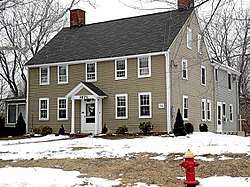Gilman-Hayden House
|
Gilman-Hayden House | |
 | |
  | |
| Location | 1871 Main St., East Hartford, Connecticut |
|---|---|
| Coordinates | 41°47′30″N 72°38′1″W / 41.79167°N 72.63361°WCoordinates: 41°47′30″N 72°38′1″W / 41.79167°N 72.63361°W |
| Area | 0.8 acres (0.32 ha) |
| Built | 1784 |
| Built by | Gilman,George |
| Architectural style | Georgian |
| NRHP reference # | 84001007[1] |
| Added to NRHP | August 16, 1984 |
The Gilman-Hayden House is a historic house at 1871 Main Street in East Hartford, Connecticut. Built in 1784, it is a good local example of Georgian architecture, and is also notable as the home of Edward Hayden, a diarist of the American Civil War. It was listed on the National Register of Historic Places in 1984.[1]
Description and history
The Gilman-Hayden House is located on a rural-residential stretch of East Hartford's Main Street, between Gilman and King Streets. It is a 2-1/2 story wood frame structure, with a side gable roof and clapboarded exterior. Its main facade faces east and is five bays wide, with a center entrance sheltered by a gabled portico. A two-story ell extends to the rear, and an enclosed porch projects to the south. The interior of the house follows a typical center-hall plan, with two rooms on either side of the hall on both floors. The interior retains many original period features, including bead-board paneling, built-in cupboards, and wrought iron hardware. The two front parlor spaces feature fine fireplace surrounds.[2]
The house was built in 1784 by George Gilman, a descendant of some of the area's earliest settlers. The Gilmans originally owned land all the way to the Connecticut River, and operated a ferry. In the second quarter of the 19th century the property came into the hands of the Williams family, whose most famous member was William Williams, a signatory of the United States Declaration of Independence. In 1867, the house was purchased by Edward Hayden, whose mother was a Williams. Hayden is most notable for the unique diary he kept of his experiences during and after the American Civil War. One portion of the diary was written on a similary diary Hayden recovered from a Confederate Army soldier, and provides a unique window into the affairs of the war.[2]
See also
References
- 1 2 National Park Service (2010-07-09). "National Register Information System". National Register of Historic Places. National Park Service.
- 1 2 "NRHP nomination for Gilman-Hayden House". National Park Service. Retrieved 2017-07-03.